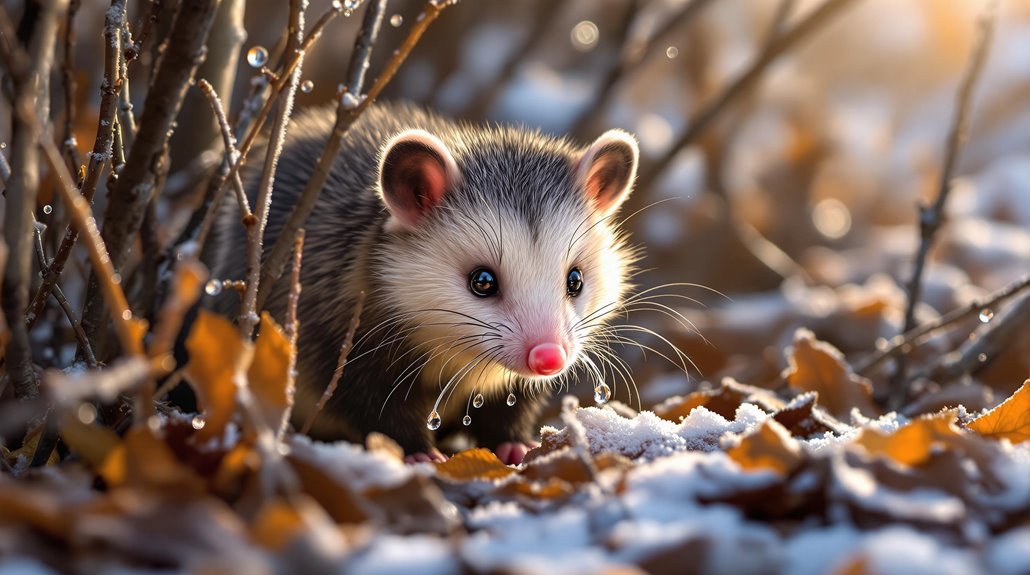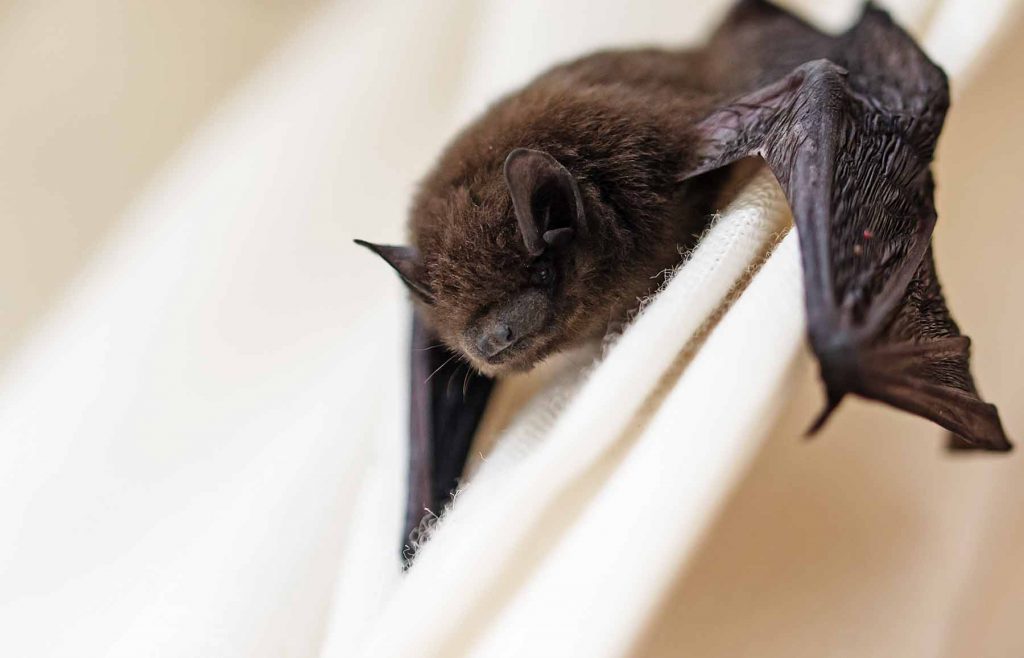Opossums in Raleigh, NC, are primarily active at night during the winter months. They adapt to cold temperatures by seeking shelter in places like hollow trees, garages, or leaf piles to stay warm. Their diet becomes more opportunistic, focusing on scavenged food from trash or hunting small animals. Instead of hibernating, they may enter a state of torpor during the coldest periods to conserve energy. Despite common fears, opossums are shy creatures that rarely pose a threat. Understanding their winter activities can enhance coexistence with these unique animals. Further insights await on their fascinating behaviors and community impact.
Key Article Highlights
- Opossums are primarily nocturnal, foraging for food during the night in Raleigh's winter months.
- They seek shelter in warmer areas like hollow trees, leaf piles, and human structures to conserve body heat.
- Opossums exhibit reduced activity during the coldest nights, entering a state of torpor instead of true hibernation.
- Their winter diet includes scavenging human waste and hunting small animals, adapting for food availability.
- Opossums contribute to pest control by consuming insects and rodents, aiding in local ecological balance during winter.
Opossum Behavior in Winter
During winter, opossum behavior reflects their adaptability and resilience in harsh conditions. These creatures are primarily nocturnal, which means they are most active during the night. As temperatures drop, opossums search for food and shelter in their winter territory. They often seek out warm places, finding refuge in dens, underbrush, or even human structures. Opossums are known for their unique communication methods. They use a variety of vocalizations, body language, and scent marking to communicate with one another. During winter, these forms of opossum communication become essential for maintaining social bonds and marking territory. They may engage in more vocal calls to assert their presence and deter potential threats. Opossums have a diverse diet consisting of insects, fruits, and small animals, which allows them to adapt their food sources based on availability. Food can be scarce in winter, so opossums rely on their keen sense of smell to locate available resources. They are opportunistic feeders, often scavenging leftovers or foraging for fruits and insects. By adapting their behavior to the changing environment, opossums demonstrate their ability to survive and thrive, even when conditions are less than favorable. Their resilience is a reflection of the freedom they embody in steering through the challenges of winter life. Additionally, as opossums venture closer to human habitation in search of food, it becomes essential to implement humane opossum control methods to prevent potential conflicts.
Adaptations to Cold Weather
Opossums have several adaptations that help them survive in cold weather. Their fur provides important insulation, keeping them warm during chilly nights. Additionally, they change their behaviors and foraging strategies to find food more effectively in winter conditions. During winter, opossums may also seek out shelter in warmer areas to help conserve body heat.
Fur Insulation Properties
As temperatures drop in winter, the fur of opossums serves as an essential adaptation to help them survive the cold. This fur provides excellent insulation, aiding in heat retention and keeping the animals warm during chilly nights. Opossums benefit from their unique fur properties in several ways:
- Thick Undercoat: The dense undercoat traps air, creating a barrier against the cold.
- Guard Hairs: Long guard hairs protect the undercoat from moisture and wind.
- Color Adaptation: The fur color can blend with surroundings, helping them avoid predators during the day.
- Layering Effect: Their fur consists of multiple layers, enhancing insulation and warmth.
These adaptations allow opossums to maintain their body temperature effectively even when external conditions are harsh. The combination of fur insulation and the ability to curl up tight when resting guarantees these creatures can thrive in the winter landscape. By understanding these adaptations, we can appreciate the resilience of opossums in Raleigh, NC, and their ability to navigate the challenges of winter weather.
Behavior Changes in Cold
With winter's arrival, opossums exhibit notable changes in behavior that enhance their survival in colder conditions. One common misconception is that opossums hibernate during the winter months. This is a hibernation myth; instead of true hibernation, opossums experience a state of torpor. During this period, they reduce their activity and conserve energy, allowing them to cope with low temperatures.
Opossums have a remarkable temperature tolerance that enables them to endure cold weather. They often seek shelter in dens, underbrush, or even abandoned structures to stay warm. While they do not fully hibernate, they may become less active, particularly during the coldest nights. This behavioral change helps them limit exposure to harsh conditions, reducing their need for food and water.
In addition, opossums may alter their foraging patterns. They tend to hunt and scavenge during warmer parts of the day to avoid the cold. By adapting their behaviors, opossums improve their chances of survival through the winter, showcasing their resilience in the face of changing climates. Understanding these adaptations can foster appreciation for these unique creatures as they navigate the challenges of winter.
Food Foraging Strategies
Adapting to the challenges of winter, opossums employ various food foraging strategies to secure sustenance. As temperatures drop, their foraging techniques shift to meet the demands of their seasonal diets. Opossums are resourceful animals, using their keen senses to find food even in harsh conditions. Here are four key strategies they utilize:
- Scavenging: Opossums often search for leftover food in dumpsters or gardens, taking advantage of human waste.
- Hunting: They hunt small animals like insects and rodents, which are still available despite the cold.
- Foraging for Fruits: In winter, they may find remaining fruits or nuts that have not yet fallen or been consumed.
- Using Shelter: Opossums may forage closer to their shelters, minimizing exposure to the cold while maximizing food intake.
These foraging strategies help opossums adapt to winter's challenges, ensuring they have enough energy to survive. By being flexible in their approach, they can thrive in the changing environment and maintain their freedom to roam and explore.
Food Sources During Winter
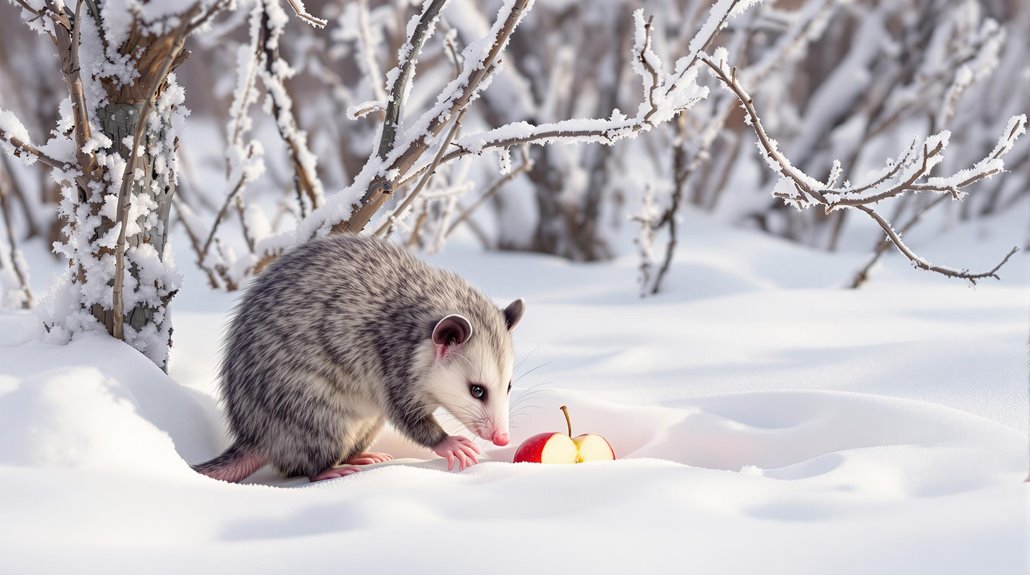
During winter, opossums face challenges in finding food due to the scarcity of natural resources. Their winter diet shifts considerably from the warmer months when food is more abundant. Opossums are opportunistic feeders and adapt their foraging behavior to the available resources. They typically seek out fruits, insects, and small animals, but these can be harder to find during colder months.
During winter, opossums often rely on scavenging for food. They may visit urban areas or garbage sites in search of leftovers. This behavior allows them to utilize human waste as a food source, which can be an essential part of their survival strategy. In addition to scavenging, they may also dig for roots or tubers in the ground.
Despite the harsh conditions, opossums have a diverse diet that helps them endure winter. They can eat a variety of foods, including plant material and carrion. Their ability to adapt their foraging behavior is fundamental for their survival in the winter season. By being flexible in their food choices, opossums can navigate the challenges of winter and continue to thrive in Raleigh, NC.
Nocturnal Activity Patterns
Opossums are primarily nocturnal animals, which means they are most active at night. During this time, they engage in foraging for food, seeking shelter, and responding to temperature changes. Understanding their nighttime activity patterns is important for studying their behavior and survival in winter months.
Nighttime Foraging Habits
As temperatures drop in winter, opossums venture out under the cover of night to search for food. Their nocturnal habits are essential for survival during this cold season. Opossums are opportunistic feeders, using various foraging techniques to find nourishment. They rely on their keen sense of smell and hearing to locate food sources.
Here are some common foraging techniques employed by opossums:
- Scavenging: Opossums often eat carrion, making use of dead animals they find.
- Fruit and vegetation: They forage for fruits, berries, and plants, which are available in winter.
- Insects and small animals: Opossums hunt for insects, worms, and even small rodents to supplement their diet.
- Human food sources: They may rummage through trash cans or gardens, seeking discarded food.
These nighttime foraging habits allow opossums to adapt and thrive despite the challenges of winter. Their ability to exploit various food sources showcases their resourcefulness. By understanding these patterns, we can appreciate the role opossums play in our ecosystems, even during the colder months.
Temperature Impact on Behavior
Temperature considerably influences the behavior of opossums, particularly their nocturnal activity patterns. Opossums are generally nocturnal, meaning they are most active at night. However, changes in temperature can affect their movement and feeding habits. As the temperature drops, opossums may alter their behavior to conserve energy and maintain body warmth.
There are specific temperature thresholds that trigger these changes. For instance, when temperatures fall markedly, opossums tend to reduce their foraging activities. This behavior modulation is a survival strategy that helps them cope with colder conditions. They may choose to stay in their dens for longer periods, waiting for warmer nights to venture out.
In Raleigh, NC, winter temperatures can vary, influencing how often opossums are seen at night. When temperatures are milder, they are more likely to be active, searching for food and exploring their territory. Conversely, during colder spells, their nocturnal activity can diminish markedly. Understanding these patterns is essential for those who wish to observe opossums in their natural habitat and appreciate their adaptability to changing environmental conditions.
Shelter Seeking Activities
When temperatures drop, opossums engage in specific shelter-seeking behaviors to protect themselves from the cold. These nocturnal creatures are known to adapt their activities based on seasonal patterns. During winter, their quest for warmth leads them to various shelter types. Here are some common choices:
- Hollow Trees: Opossums often find refuge in the cavities of trees, providing protection from harsh weather.
- Brush Piles: They seek out dense underbrush or piles of leaves, where they can hide from predators and stay warm.
- Sheds and Garages: Opossums are not shy about exploring human structures. They may take shelter in sheds or garages that are left open.
- Burrows: Some may dig small burrows or use abandoned ones from other animals, which offer a cozy place to stay.
These shelter-seeking activities are crucial for their survival during the cold months. By understanding these behaviors, we can appreciate how opossums adapt to their environment while enjoying their natural freedom.
Urban vs. Rural Habitat
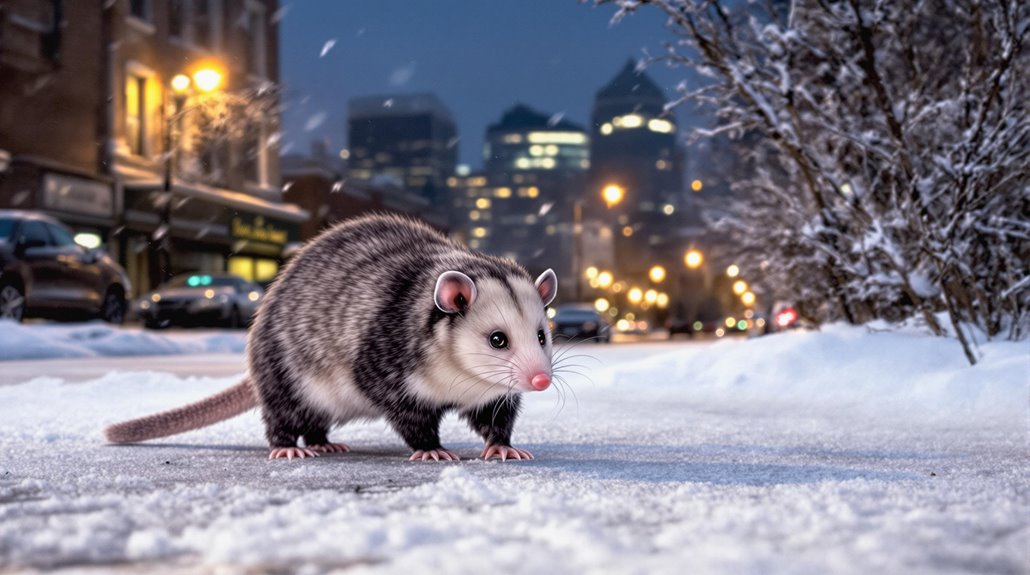
Although opossums are adaptable creatures, their activity patterns markedly differ between urban and rural habitats. In urban habitats, opossums often face habitat fragmentation due to human encroachment. This results in smaller patches of wilderness, which can limit their movement and access to resources. The availability of food in cities can be high, as opossums scavenge through garbage and find easily accessible meals. However, they must also navigate increased predator presence, such as dogs and cars, which can pose significant risks.
In contrast, rural habitats typically offer a more expansive environment. Opossums in these areas benefit from greater resource availability, including natural food sources like insects and fruits. The lower levels of human disturbance allow for easier environmental adaptation and more natural behavior. These creatures tend to have distinct habitat preferences in rural settings, where they can find shelter in dense vegetation and avoid predators more effectively.
Opossum Social Structure
Opossums exhibit a solitary social structure, primarily interacting with others during mating seasons or when raising young. Outside of these times, they prefer to maintain independence, which reflects their overall social hierarchy. The group dynamics among opossums are minimal but can be characterized by a few key behaviors:
- Territoriality: Opossums often establish territories that they will defend against other opossums.
- Mating Interactions: During the breeding season, males and females come together, leading to brief social interactions.
- Mother-Offspring Bond: A female opossum will care for her young, forming a temporary social unit during their early development.
- Avoidance of Conflict: Opossums tend to avoid confrontations, using strategies like playing dead to escape threats.
In their natural habitat, opossums thrive as solitary animals, which allows them the freedom to explore and forage without the constraints that come with group living. This independence is vital for their survival and adaptability in various environments, especially during the winter months when resources may be limited.
Impact of Winter on Reproduction
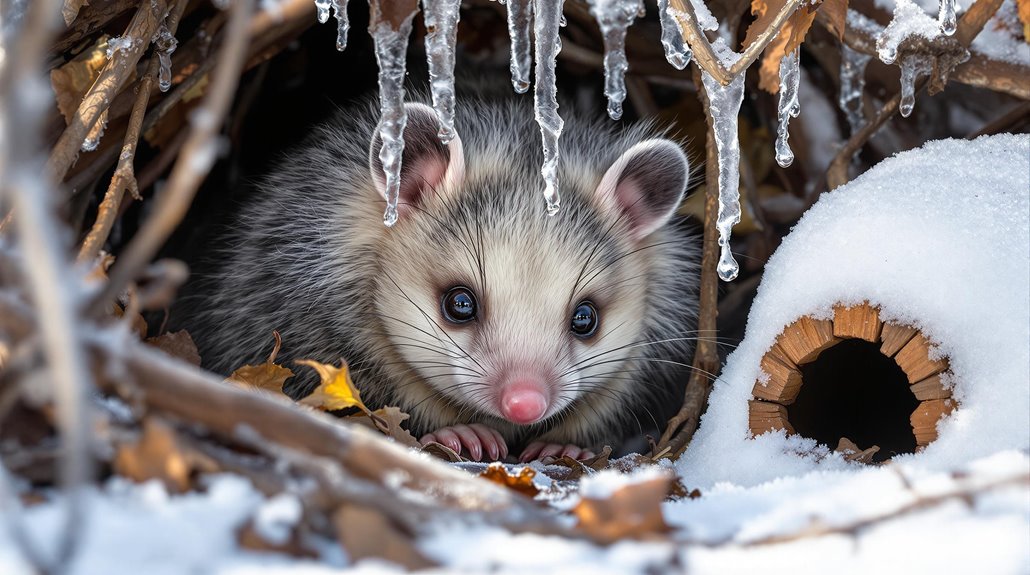
Winter can considerably affect the breeding seasons of opossums. As temperatures drop, these animals may adjust their reproductive strategies to improve their chances of survival. Understanding these changes is important for studying opossum populations in colder climates.
Breeding Seasons Shift
As temperatures drop and food becomes scarce, the reproductive patterns of opossums may undergo significant changes. The breeding timing of these creatures can shift, impacting their reproductive health. Winter conditions can alter when and how often opossums mate, leading to various outcomes.
Here are four key effects of winter on opossum breeding:
- Delayed Mating: Cold weather can postpone mating activities until spring, as opossums seek to conserve energy.
- Reduced Litter Size: Limited food sources may lead to smaller litter sizes when breeding does occur, affecting population growth.
- Stress Factors: Harsh winter conditions can increase stress levels, which may negatively impact reproductive health and hormone production.
- Survival of Offspring: If breeding occurs too late in the season, the survival of young opossums may be compromised due to insufficient resources.
Survival Strategies Adapt
Although harsh conditions can pose challenges, opossums have developed various survival strategies to adapt their reproductive behaviors during winter. These strategies are essential for guaranteeing the continuation of their species in the face of cold weather and increased predator presence.
One key adaptation is the timing of reproduction. Opossums may delay breeding until temperatures become milder, which helps guarantee that their young have a better chance of survival. This shift allows mothers to find food more easily, providing nutritious milk to their offspring. Additionally, by timing reproduction with warmer months, young opossums can grow stronger before facing winter's dangers.
To further enhance their survival, opossums exhibit behaviors aimed at predator avoidance. During winter, they may seek shelter in more secure locations, reducing the risk of becoming prey. Their ability to adapt to changing climates demonstrates their climate resilience, allowing them to thrive despite seasonal challenges.
Common Misconceptions About Opossums
Many people hold misconceptions about opossums that can lead to misunderstandings about their behavior and ecological role. These misunderstood creatures are often seen as pests, but they play an essential part in our environment as beneficial scavengers. Here are four common misconceptions:
- Opossums are dangerous: Opossums are generally non-aggressive and prefer to avoid confrontation. They are unlikely to harm humans or pets.
- They carry rabies: Opossums have a low body temperature, making it hard for rabies to survive in them. They are one of the least likely animals to carry this disease.
- Opossums are pests: Instead of being pests, they help control insect and rodent populations by eating them. They also consume carrion, cleaning up the environment.
- They play dead to deceive: While opossums can "play dead" as a defense mechanism, this is a natural response to stress, not a deceitful tactic.
Understanding these points can help shift perspectives on opossums, recognizing their value in our ecosystems. By dispelling these myths, we can appreciate their role and coexist peacefully.
Human-Opossum Interactions
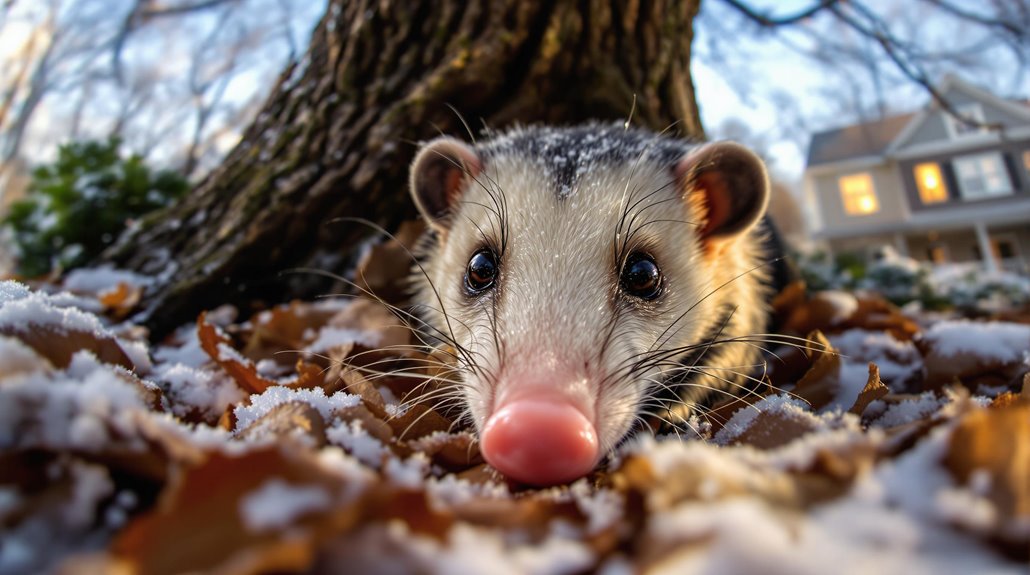
Human-opossum interactions are often characterized by misunderstanding and fear. Many people view these creatures as pests rather than valuable members of our urban wildlife. However, educating the community about opossum behavior can foster a better understanding and promote coexistence strategies that benefit both humans and wildlife.
| Human Behavior | Opossum Encounters | Community Awareness |
|---|---|---|
| Fear of the unknown | Curious but shy | Education initiatives |
| Avoidance tactics | Mostly nocturnal | Workshops and talks |
| Habitat encroachment | Rarely aggressive | Informative materials |
| Misinterpretation | Role in ecology | Neighborhood programs |
| Wildlife conflict | Pest control ally | Local wildlife groups |
Promoting wildlife education can create a sense of ecological balance. Opossums help reduce pests and contribute to animal welfare by controlling insect populations. By encouraging positive interactions, we can change perceptions and enhance human-opossum relationships. Community awareness is essential to cultivate a harmonious coexistence with these unique creatures, ultimately benefiting our environment and local ecosystems.
Conservation Efforts in Raleigh
Building on the importance of wildlife education, conservation efforts in Raleigh play a significant role in protecting local species, including opossums. These efforts not only focus on the animals but also emphasize habitat preservation and community involvement.
Here are some key initiatives in Raleigh:
- Habitat Restoration: Projects aim to restore natural habitats, providing safe spaces for opossums and other wildlife to thrive.
- Public Workshops: Educational programs help residents understand the importance of coexisting with local wildlife, promoting positive interactions.
- Volunteer Opportunities: Many organizations encourage community members to participate in conservation activities, fostering a sense of responsibility and connection to nature.
- Wildlife Corridors: Creating pathways between habitats helps animals navigate urban areas safely, reducing the risk of accidents and promoting healthy populations.
Frequently Asked Questions
Do Opossums Hibernate During the Winter Months?
Opossums do not hibernate during winter months. Instead, their behavior adapts for winter survival. They may reduce activity and seek shelter, but they remain active, foraging for food in response to environmental conditions.
What Is the Lifespan of an Opossum in Winter?
The lifespan of an opossum typically ranges from two to four years. During winter, their behavior adapts for survival, relying on shelters and food sources to navigate the challenges posed by colder temperatures and reduced resources.
How Can I Safely Deter Opossums From My Property?
To safely deter opossums from your property, use humane traps to relocate them. Additionally, apply natural repellents like vinegar or citrus scents around your yard to discourage their presence without causing harm.
Are Opossums Active During the Day in Winter?
While many assume opossums are nocturnal, they may exhibit daytime behavior in winter. During this season, they occasionally engage in winter foraging for food, adapting to environmental pressures and changing availability of resources.
What Diseases Can Opossums Carry in Winter?
Opossums can carry diseases such as leptospirosis and salmonella, which may pose risks to winter health. While generally low-risk, awareness of opossum diseases is essential for maintaining a safe environment during colder months.
